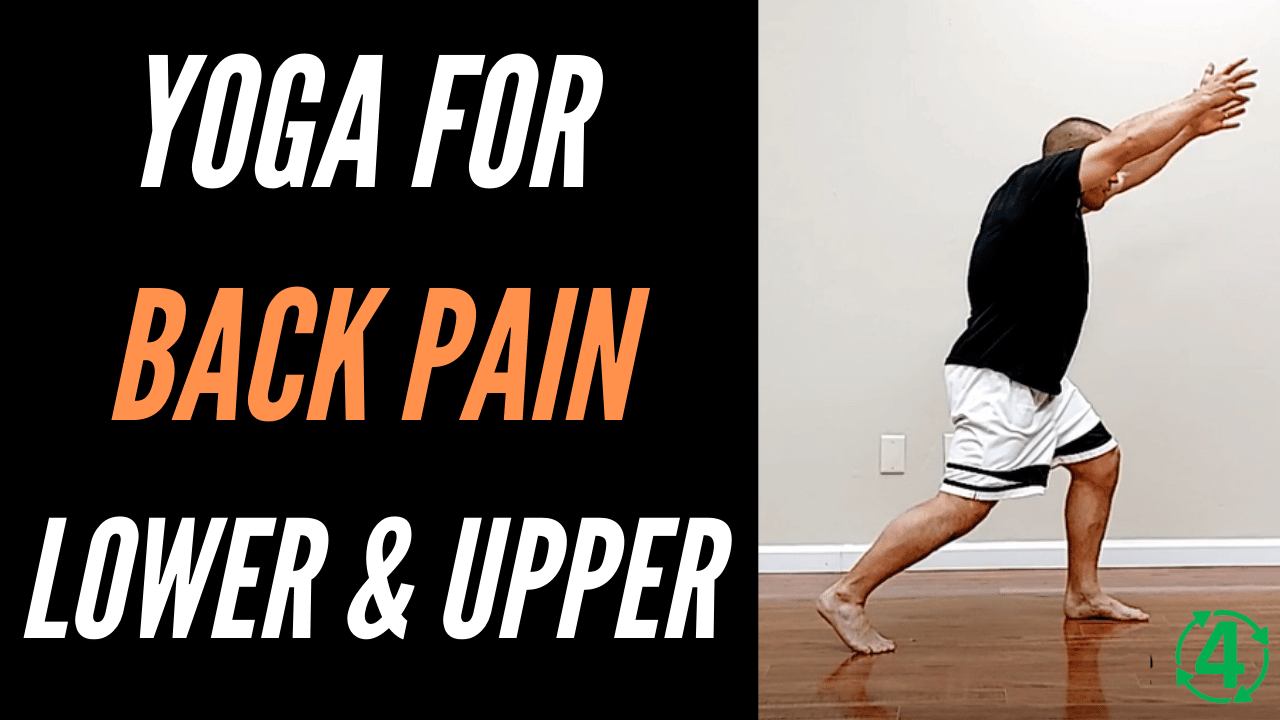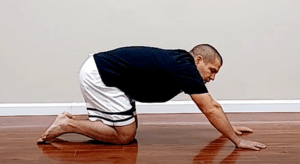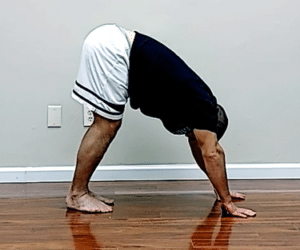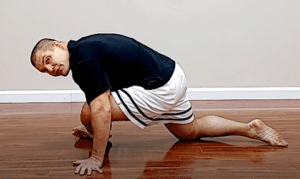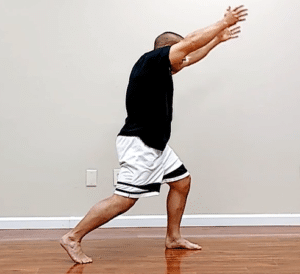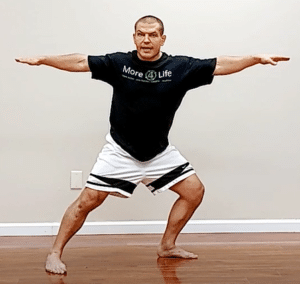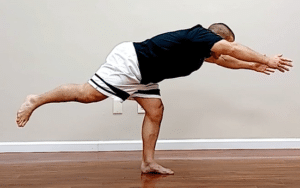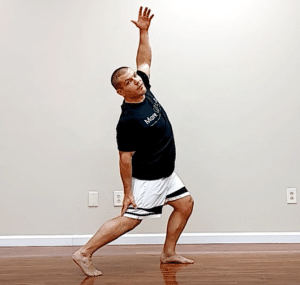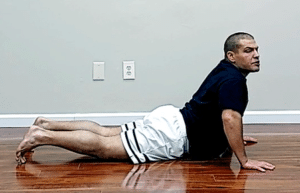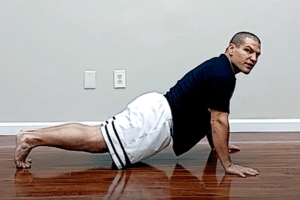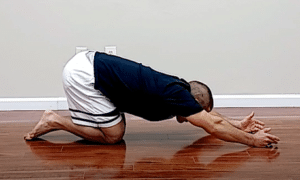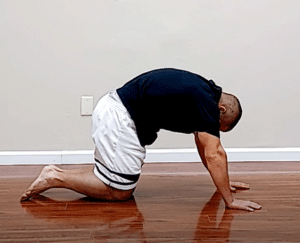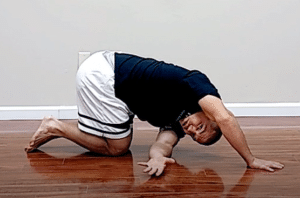Is Yoga Good For Lower Back Pain?
What About Yoga For Upper Back Pain?
Watch this 12-minute video to learn the best yoga poses for lower and upper back pain. Plus, learn what poses to avoid so that you don't cause lower back pain from yoga.
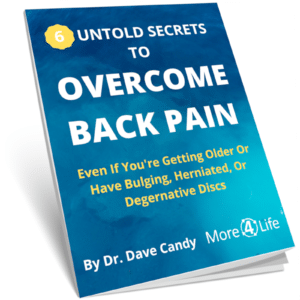
Is Yoga Good For Lower Back Pain?
The short answer is: YES, yoga is good for lower back pain, IF you do it right.
Overall exercise, stretching, and mindfulness are good for lower back pain, but certain poses can actually cause lower back pain from yoga.
In this post we'll cover:
- How does yoga help back pain?
- What are the best yoga lower back pain poses?
- Which poses can CAUSE lower back pain from yoga?
- What about yoga for upper back pain?
- 3 reasons why watching a yoga lower back pain video on YouTube might not fix your back pain
How Does Yoga Help Back Pain?
Background
The earliest forms of yoga were practiced in Ancient India during the 4th century BCE. Yoga has evolved significantly since ancient times to the familiar modern form that it is known for today.
However, the premise of yoga has remained consistent from its origins where one utilizes physical and mental strategies to achieve a state of well-being.
General Effects Of Yoga On Pain
Yoga practitioners utilizes a series of meditative practices to recognize and achieve a state of “witness-conciousness” free from any external attachment. This sense of consciousness allows the practitioner to achieve freedom from pain and suffering.
The National Institute of Health and Johns Hopkins Medicine have also asserted that yoga improves balance, strength, flexibility, joint pains, cardiovascular health, relaxation, sleep, mood, and stress management. Yoga’s power to heal the mind and body makes it a popular tool to supplement a healthy lifestyle.
As a result, yoga is for everyone regardless of age, experience, health status, and size.
What Are The Best Yoga Lower Back Pain Poses?
The most popular yoga poses include: child’s pose, downward-facing dog pose, and cobra pose. Each of these poses have their benefits, drawbacks, and can be modified to fit individual needs.
Child’s Pose
The child’s pose is typically the default resting position between transitioning from one “active” pose to another.
Child's pose enables a person to gently stretch the shoulders, spine, hips, and the front of the thighs. Depending on the position you hold your spine, you can target different muscles. That's why it's one of the best exercises to relieve lower back pain.
However, the kneeling position can be hard on your knees, especially if you have knee arthritis or cartilage loss in your knees.
Modifications include:
- using an extra thick yoga mat
- placing a pillow or towel roll under your knees or shins
- decreasing the range of motion- meaning NOT going as far back as possible.
Variations
- Keep your back relatively flat to target your hip joint mobility more
- Allow your lower back to round to stretch your lower back muscles
- Walk your hands forward to stretch your upper back and lats more
Downward Facing Dog Pose
The downward facing dog pose actively stretches your shoulders, spine, hamstrings, and calf muscles.
It's important to keep your feet flat on the floor in order to stretch your calves.
Downward facing can be hard on your wrists though, especially if you have wrist pain.
Modifications include:
- bearing weight on a closed fist rather than your palm so that your wrist stays in a neutral position
- placing your forearms on the ground instead of bearing weight on your wrists and hands
- decreasing the range of motion- meaning decreasing the “pike” position by slightly lowering the buttocks towards the floor or slightly bringing the heels up.
Like the child’s pose, it's important to maintain a neutral spine positioning by gently tucking the chin in, squeezing shoulder blades together, and abdominal contraction. Also avoid this pose if you have high blood pressure as it increases blood pressure in your head.
Pigeon Pose
The pigeon pose is a good way to stretch your piriformis and hip rotator muscles. You should feel this stretch in the buttock of your front leg.
It is actually quite difficult to do. The picture above shows a modified pigeon pose. Other modifications could include putting a yoga block under your front buttock.
People with a great amount of flexibility can get their front leg all the way flat on the ground while in the position above. However, that's not me and it may not be you either.
That's OK. It doesn't mean you can't do yoga.
You just need to learn how to modify the poses appropriately.
Warrior Poses Are Good For Back Pain
The Warrior Poses (Warrior 1, 2, and 3) are poses that involve standing with your feet staggered. Warrior 1 and 2 are great hip flexor stretches
Warrior 1
In Warrior 1, you face with your hips straight ahead. Keep your lower back in a neutral position as you raise your arms over your head.
If you have stiff lat muscles, you may not be able to raise your arms over your head all the way without arching your lower back. That's OK.
It is better to keep your lower back in a neutral position than it is to get your arms all the way over your head. If needed, modify the pose as shown above so that you can keep your lower back in a neutral position.
Warrior 2
In Warrior 2, your hips and pelvis face side to the side. This stretches your inner thigh muscles as well as your hip flexor muscles.
Make sure that if you have pain on the inside of the knee, that you don't stretch too far. This pose can put stress on the inner side of the back knee as well as on the the front knee.
Warrior 3
The Warrior 3 pose is a balance and stabilization pose. It's important to keep your lower back in a neutral position without arching it or rotating it.
If you have stiff hip flexors, you may not be able to extend your back leg all the way up to your trunk without causing your back to arch. If that's the case just modify the pose as shown above.
Warrior 3 pose does require a fair amount of balance, so either make sure you have the balance to do it without falling, or have a sturdy chair or couch that you can hold onto.
Which Poses Can CAUSE Lower Back Pain From Yoga?
Reverse Warrior Pose
While Warrior 1, 2, and 3 are good for lower back pain, the reverse warrior pose is.... well, the reverse of good.
In this pose your run your hand down your back leg and arch your back into hyperextension. For that reason, the Reverse Warrior and other poses that require excessive back arch can actually cause lower back pain.
Cobra Pose
The cobra pose is designed to actively stretch the abdominal muscles and hip flexors.
However, this yoga pose can cause lower back pain if you arch too much, especially if you're over the age of 50.
As a result, avoid this pose if you have a lower back pain.
Modifications include:
- decreasing the range of motion by keeping the elbows slightly bent and only lifting the trunk up a little bit off the floor
- pushing the trunk off the floor through forearms with the elbow bent instead of using the hands/wrist.
Upward Facing Dog
The upward facing dog pose looks very similar to the cobra pose above.
So what's the difference between the cobra and upward facing dog?
In the cobra, you sag your hips down and keep your pelvis flat on the floor. Therefore, the cobra is more of a flexibility exercise.
In the upward facing dog on the other hand, you keep your pelvis off of the floor and allow the hips to sag. It's more of a stability exercise.
However, just like the cobra, it does require quit a bit of arch in your lower back, and for the same reason, the upward facing dog it a yoga pose you should avoid if you have lower back pain.
Need Help For Back Pain?
Click the button below to discover how we can help
What About Yoga For Upper Back Pain?
The most popular yoga poses for upper back pain include: modified child's pose, the cat-camel and the thread the needle. Like the yoga poses for lower back pain, each pose will have their benefits, modifications, and reasons for avoiding them.
Modified Child's Pose (Lat Stretch)
As noted above, the child's pose is one of the best yoga poses for back pain - both lower and upper. In this variation, you walk your hands out as far forward as possible and lower your chest to the ground.
This helps create extension (backward bend) in the upper back. If you can get more arch in the thoracic area, you won't excessively bend backward in the lower back.
Cat - Cow (a.k.a. Cat - Camel) Pose
During the cat-cow pose, you get on all 4's and arch your upper back up to the ceiling and then back down toward the floor. A key point is to make sure the movement is coming from your upper back between the shoulder blades.
In cat pose (marjaryasana), you arch your back upward like an angry cast. The goal is to stretch the muscles in the upper back and shoulder blades as well as move your spine into flexion.
When you arch down and let your belly hang low (like a cow), you mobilize your spine into extension.
Make sure that you're moving your whole spine evenly. Most people have more extension mobility in their lower back than in their upper back.
You don't want to arch excessively from the lower back so that it causes two humps like a camel (your upper back and butt). Rather, you want a nice smooth curve in your back like a cow. ( The yoga name for this pose is bitilasana. In Sanskirt, bitila = cow and asana = pose)
If you have lower back pain already, you may just want
Thread The Needle Pose
The thread the needle pose works on twisting mobility through your upper trunk.
To do it, you thread your right arm and shoulder under the opposite armpit and twist from the upper trunk. Its important to to allow the twisting to occur from your lower back.
Similar to the seated version of this pose, this pose is used to stretch the shoulder and upper- to mid-back muscles. The large twisting moment of the pose can cause pain on the neck and lower back, especially if you already have pre-existing conditions to those areas. You can modify this pose by: tightening/engaging your abdominal muscles; gently tucking your chin in towards your throat while rotating your head; and decreasing the range of motion of the twist to decrease the strain on your neck and low back. Move only to the point where you feel the stretch on mid-back without strain on your neck and low back.
3 Reasons Why Watching A Yoga For Lower Back Pain Video On YouTube Might Not Fix Your Back Pain
1. Technique & Intensity
Will you do the yoga poses correctly and modify appropriately?
Modifications need to be made to tailor each yoga pose to your own physical needs and limitations in order to achieve its intended effects without causing injury.
When you're watching a yoga for lower back pain video on YouTube, it's one-way communication. You're receiving generalized, one-size fits most instruction, but the YouTube creator can't see you or give you feedback. As such, you don't know if you're actually doing the stretches in a manor that's best for your body.
When yoga for back pain, it's also important to do belly breathing, move slowly between poses, and only move within a pain-free range of motion.
It's also important to check the credentials of the YouTube creator as literally anyone can have a YouTube channel. (Yes, I realize the irony that you're watching my YouTube channel, but you can check out my credentials here)
Most yoga instructors are used to working with generally healthy people, so you have to make sure that the creator has a thorough understanding of anatomy and biomechanics.
2. Consistency, Motivation, & Accountability
Will you actually do it, and keep doing it?
Ideally, if you have back pain, you should do perform these yoga poses almost daily in order to see improvements in your pain, mobility, and daily function. If you're just looking to prevent back pain, doing yoga a few times per week should suffice.
However, life gets busy and it can be hard to stay motivated to consistently perform these yoga poses daily or even a few times per week.
If you're in a class or an in-person group, other people in the class and/or the instructor hold you accountable to actually show up and do the yoga. (It only works if you do it 😉)
Click here to learn about our Yoga classes.
3. Addressing the Root Cause:
Doing yoga on a regular basis may help with your overall mental and physical health, but it may not necessarily stop your back pain for good.
Why?
Because yoga doesn't address the root cause of your pain... the thing that your back pain to start in the first place. Although doing yoga may relieve your back pain temporarily, if you don't fix the root cause of the pain, it will eventually come back.
Want To Discover The Root Cause Of Your Back Pain?
Click the button below to request a Free Discovery Visit with a Back Pain Specialist.

